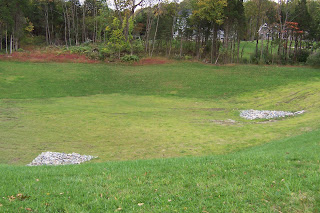Gardening as Process: Planning and Mapping -1
 The next step in creating a garden is to map out what goes where. This can be as simple or complex as you like. You can purchase a computer-based design program, buy a plastic landscape template, or just make a bubble diagram. I prefer to start with a bubble diagram on 11” x 17” quadrille paper, which allows you to work on the larger scale needed to envision an entire yard. Use pencil and get a big eraser.
The next step in creating a garden is to map out what goes where. This can be as simple or complex as you like. You can purchase a computer-based design program, buy a plastic landscape template, or just make a bubble diagram. I prefer to start with a bubble diagram on 11” x 17” quadrille paper, which allows you to work on the larger scale needed to envision an entire yard. Use pencil and get a big eraser.Next, you need to step outside. Look around. What are your lines of sight? Where is your eye naturally drawn? For better or for worse, these are your existing focal points. It’s important to deal with reality here, because you’re gathering vital information that will make or break your garden design. Don’t shrink from drawing an arrow from your back door to your neighbor’s plastic play set, if that is the dominant element in your garden view. Until you address such 800-pound gorillas, the garden will never look right.
Compare where your eye is drawn now to where you would like it to be drawn. If there is an eyesore there that can’t be removed, you’ll need a screening mechanism --- a wall, a fence, a trellis, maybe even a door. Be careful in your choice, because the screen is likely to draw attention to itself, unless you use a lot of camouflage or distraction.
If the garden simply lacks structure, direct the eye by creating a focal point such as a bench, a trellis, an urn, a sundial, a birdbath, a fountain, a statue or other garden ornament, along a visual axis. The axis can be hardscape, such as a brick path, or planted, such as an alee of hedges or trees.
In small gardens, a single major focal point along a major axis is sufficient. If you’re feeling adventurous, you can add a minor cross-axis with secondary focal points at each end. Larger gardens can handle more complex layouts, but too many focal points in any size garden will result in a hodge-podge.
Now, think about how you want to use your space. Will dogs or children need room to run? Do you host large parties or charity fundraisers? Will a swimming pool be worth the expense? Where’s the best spot for your birdfeeders? The veggie plot or fruit orchard? When you lounge outdoors, which direction do you want to face? If you like to dine outside, do you prefer to set up on the lawn or on a terrace? Where’s the work area for the family gardener (potting table, greenhouse, garden shed, compost pile, brush heap)? What about lawn sports? Draw each of these activity areas, in pencil, as a free-form circle or ellipse on the bubble diagram --- no talent required.

